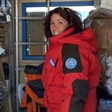Atmospheric Deposition in Polar Regions
A special issue of Geosciences (ISSN 2076-3263).
Deadline for manuscript submissions: closed (31 December 2022) | Viewed by 523
Special Issue Editors
Interests: atmospheric depositions; chemical composition of atmospheric aerosol; ice core records
Interests: analytical and environmental chemistry; voltammetry and in-situ voltammetry; atomic absorption spectroscopy; inductively coupled plasma–mass spectrometry; unmanned aerial vehicles for atmospheric analysis; atmospheric depositions; chemical composition of atmospheric aerosol; metal speciation in seawater; environmental chemometrics
Special Issues, Collections and Topics in MDPI journals
Interests: microalgae; microphytobenthos; phytoplankton; harmful algal blooms; environmental factors
Special Issues, Collections and Topics in MDPI journals
Special Issue Information
Dear Colleagues,
Atmospheric depositions (dry depositions of particles, wet depositions, and occult depositions by fog and mist) are the most important processes through which atmospheric pollutants are removed and transferred to terrestrial and aquatic ecosystems. Research on atmospheric deposition has increased a great deal over recent years because of its significant contribution in assessing the impact of organic and inorganic pollutants on different ecosystems, and performing source apportionment to receptor sites at long and short distances from the source. Atmospheric depositions in polar regions may be prone to complex processes occurring at the snow/atmosphere and soil/atmosphere interfaces and are influenced by a number of factors, including the production, transport, and deposition of aerosols on snow/soil surfaces, as well as any transformations they undergo after deposition.
Only by knowing the current atmosphere/snow and snow/atmosphere exchange functions is it possible to ascribe variations observed in chemical profiles to actual climatic or environmental variations.
In addition to direct physical and chemical methods of atmospheric deposition monitoring, bioindicators have also been used to evaluate air pollution. Use of mosses as a biomonitor is a well-established technique to estimate atmospheric deposition on a geographical basis since these species obtain most of their nutrients directly from wet and dry deposition. Recently, mosses and lichens have been used even in polar regions to measure pollution on a larger time scale. The aim of this Special Issue is to assemble a suite of papers providing interpretation of a number of areas. These may include but are not limited to:
- Chemical–physical characterization of atmospheric depositions and assessment of the inter-annual and seasonal variations over long periods;
- Reconstruction of the history of the atmospheric environment at a specific location through chemical and physical analysis of snow and ice samples form snow pits and ice/firn cores;
- Understanding of the factors which control the preservation of components which are not irreversibly fixed in snow layers. This will provide useful information on the deposition (wet and dry deposition, uptake of gaseous species) and post-depositional (photochemical processes, effect of the sublimation/condensation cycles) processes of environmental markers, very important for the interpretation of the stratigraphies of such markers in ice cores;
- Evaluation of the spatial variability in snow accumulation rate and chemical composition to test the possible relationships of chemical markers with current and available measurements of climatic and environmental parameters (sea ice, solar activities, etc.);
- Evaluation of the contribution of atmospheric depositions on soil and snow in coastal sites where a great number of human activities take place (scientific stations, flying and shipping operations, fishing, increasing tourism impact);
- Modeling studies helping to assess global atmospheric particle emission and deposition as well as atmospheric transport;
- Increased accuracy and coverage in many observations, in order to feed predictive climatic models and to verify model simulations;
- Evaluation of the potential role of mosses and lichens as bioindicators of spatial temporal trends of pollutant deposition in coastal ice-free areas;
- Assessment of the environmental fate of pollutants in polar terrestrial ecosystems.
Dr. Laura Caiazzo
Prof. Dr. Silvia Illuminati
Prof. Dr. Stefano Accoroni
Guest Editors
Manuscript Submission Information
Manuscripts should be submitted online at www.mdpi.com by registering and logging in to this website. Once you are registered, click here to go to the submission form. Manuscripts can be submitted until the deadline. All submissions that pass pre-check are peer-reviewed. Accepted papers will be published continuously in the journal (as soon as accepted) and will be listed together on the special issue website. Research articles, review articles as well as short communications are invited. For planned papers, a title and short abstract (about 100 words) can be sent to the Editorial Office for announcement on this website.
Submitted manuscripts should not have been published previously, nor be under consideration for publication elsewhere (except conference proceedings papers). All manuscripts are thoroughly refereed through a single-blind peer-review process. A guide for authors and other relevant information for submission of manuscripts is available on the Instructions for Authors page. Geosciences is an international peer-reviewed open access monthly journal published by MDPI.
Please visit the Instructions for Authors page before submitting a manuscript. The Article Processing Charge (APC) for publication in this open access journal is 1800 CHF (Swiss Francs). Submitted papers should be well formatted and use good English. Authors may use MDPI's English editing service prior to publication or during author revisions.
Keywords
- surface snow
- ice cores
- snow pits
- snow/atmosphere interface
- depositional and post-depositional processes
- soil/atmosphere interface
- surface soil pollution
- atmospheric pollutant deposition
- biomonitoring
- seasonal evolution of atmospheric depositions
- chemical characterization
- mosses and lichens as bioindicators







